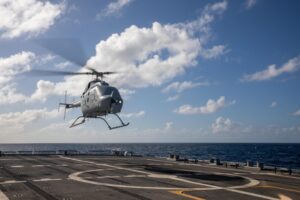The Navy is developing a new mine countermeasure system sensor suite to be used on the Northrop Grumman [NOC] MQ-8C Fire Scout unmanned helicopter, with a prototype test set for this spring, the Navy said on March 2.
The new capability is called the Single System Multi-Mission Airborne Mine Detection (SMAMD) Future Naval Capability Program and it aims to help the Fire Scout detect and localize mines and obstacles on land and at sea.
The Fire Scout program office is working with the Office of Naval Research, Program Executive Office Unmanned and Small Combatants (PEO USC), Naval Air Warfare Center Aircraft Division’s (NAWCAD) AIRWorks, Aircraft Prototype Systems Division (APSD), Webster Outlying Field (WOLF), and Air Test and Evaluation Squadron Two Four (UX-24) to conduct the final phase of the SMAMD test program.
The Navy said SMAMD will be the first MCM system flown aboard at MQ-8C and will be the aircraft’s heaviest payload thus far.
SMAMD was developed by BAE Systems. It uses an airborne optical sensor suite that aims to combine real-time onboard processing and low false alarm rates to allow warfighters to respond quickly to detected threats
The Navy noted that current MCM technologies entail post-mission analysis that increases the entire threat detection and mitigation timeline.
“This capability is extremely important as we see future fights occurring in the littoral waters where mine warfare is prevalent. A mine warfare capability will greatly reduce risk for LCS and other vessels in the littoral,” Capt. Thomas Lansley, Fire Scout program director, said in a statement.

SMAMD also seeks to prove an MCM system on a pod can operate as intended on the MQ-8C without causing adverse effects to the vehicle or significantly diminishing time on station.
Last month, UX-24 conducted Flying Qualities and Performance (FQ&P) with the MQ-8C using “mass equivalency models in place of the prototype system pods, which mimic the size and weight of the SMAMD System,” the Navy said.
RQ&P testing is used to collect data to allow for the evaluation of air vehicle performance and handling to assess safety of flight assessment and airworthiness, the service added.
This upcoming spring the SMAMD team will hold a land-based demonstration of the prototype at Naval Surface Warfare Center in Panama City, Fla., to gather performance data that will inform future MQ-8C and SMAMD integration efforts.
The Navy said the demonstration will cover the beach zone, drifting mines and mired mines in shallow water and deep water up to 10 kilometers offshore.
“The program office will continue to gather information to inform future integration efforts of the COBRA Block II System onto the MQ-8C,” Lansley added.
The Navy uses the Coastal Battlefield Reconnaissance and Analysis (COBRA) program to conduct aerial tactical reconnaissance from Fire Scout vehicles, particularly to detect and localize mines and minefields in the surf and beach zones near the water surface.
COBRA Block I, built by Arête Associates, conducts mine countermeasures operations and provides daytime mine and obstacle detection from MQ-9B variant aircraft. The Block II seeks to increase those capabilities by enhancing surface and near surface detection and imagery to include night time detection of individual moored and drifting mine-like objects, minefields and minelines from the surf zone through deep water in a single pass.